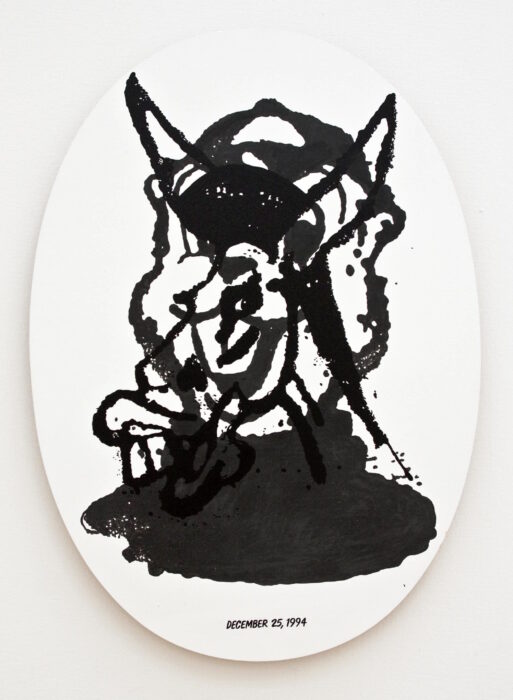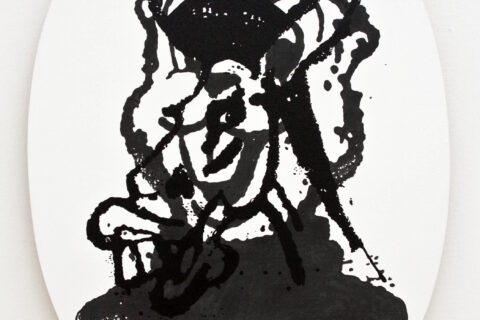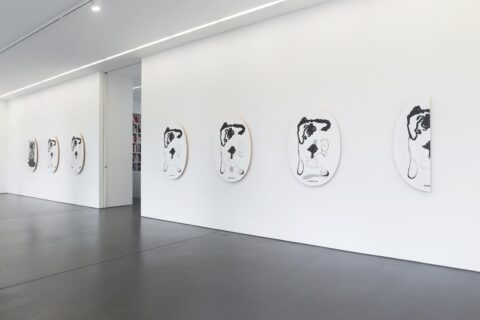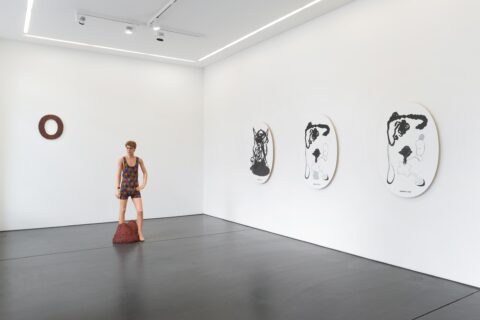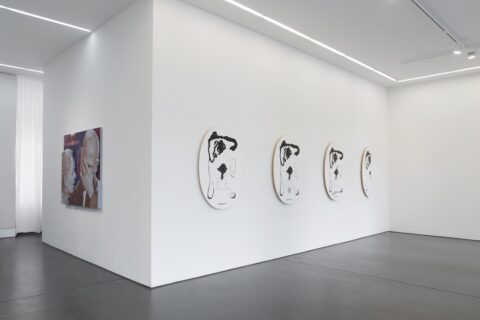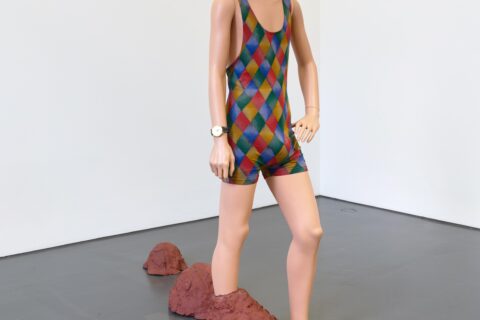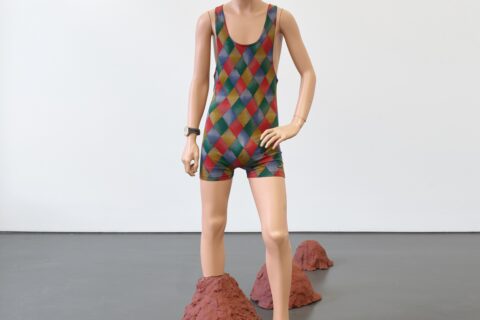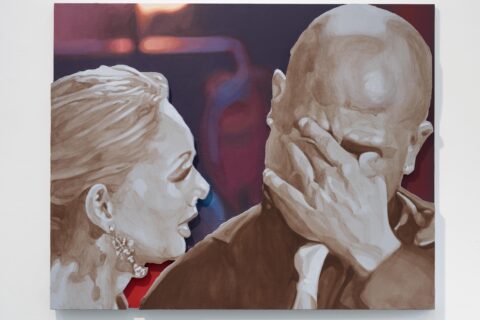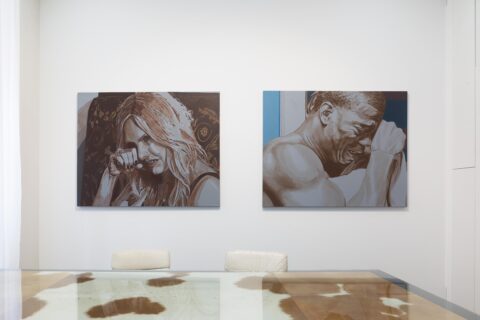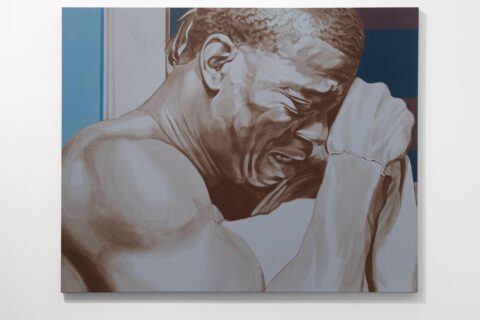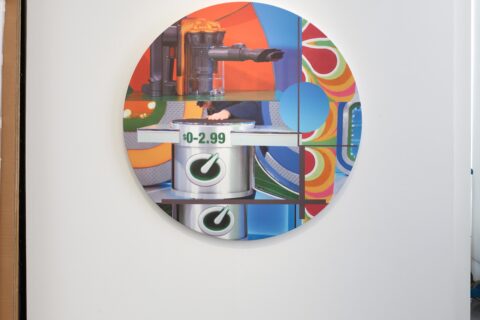Mike Kelley & John Miller Mike Kelley & John Miller
26/04/2024 – 22/06/2024
Galerie Nagel Draxler
Weydingerstr. 2/4
10178 Berlin
Opening / Eröffnung:
Donnerstag, 25. April 2024, 18 – 21 Uhr
Thursday, April 25, 2024, 6 – 9pm
Öffnungszeiten / Opening hours:
Dienstag - Freitag 11 – 18 Uhr, Samstag 12 – 18 Uhr
Tuesday - Friday 11am – 6pm, Saturday 12 – 6pm
Besondere Öffnungszeiten während des Berlin Gallery Weekends /
Special Opening hours during Berlin Gallery Weekend:
Freitag, 26. April 2024, 11 – 21 Uhr, Friday, April 26, 2024, 11am – 9pm
Samstag, 27. April 2024, 11 – 18 Uhr, Saturday, April 27, 2024, 11am – 6pm
Sonntag, 28. April 2024, 11 – 18 Uhr, Sunday, April 30, 2024, 11am – 6pm
Press Release
*Please scroll down for the German version.*
Galerie Nagel Draxler is proud to present an exhibition of outstanding works by American artists Mike Kelley and John Miller. The two friends and colleagues, both born in 1954, both studied at the California Institute of the Arts in Los Angeles in the late 1970s and maintained an intensive exchange on topics of art, politics and American popular culture and their roots in the American unconscious until Kelley's death in 2012.
On Mike Kelley's Paintings in Time
Rumor has it that Mike Kelley hated the time between Christmas and New Year because there was no one to distract him from the boredom, and because people were spending time with their families, which is a difficult time for those who don't have a family. This is also the reason why the last of his Paintings in Time, dated December 31, is cut in half. It is the day when life begins again.
In a chart illustrating the genesis of works on display in the exhibition Educational Complex Onwards 1995-2008, Mike Kelley describes the Paintings in Time as counterpart to the Timeless Paintings (1993-), an open series that directly refers to his art school education under the influence of Hans Hofmann’s push and pull theory. Far from being timeless the Paintings in Time, created on seven consecutive days between Christmas Day and New Years 1994, can be regarded as a key work in a period of transition between Kelley's yarn and fabric toy works to the Educational Complex, 1995. Citing typical motifs from his oeuvre like the beaver and the donkey (American Football mascots) and cartoon-like characters modeled after human intestines, the Paintings in Time are, as his early works, executed in black and white. Except for the first painting, dating from December 25th (Christmas Day), Kelley copied the same image every day with varying gestural patches of light grey. The last panel dated December 31st is cut in half. Oval in shape, the works evoke mirrors and at the same time point back to a previous work of transitional meaning, Cosmic egg-brown Baby from HALF A MAN, a body of work shown 1988 at the Renaissance Society in Chicago, introducing felt banners, stuffed animals and Afghan assemblages to a wider audience for the first time. Announcing a new turning point in Kelley's artistic biography in 1995, the Paintings in Time appear like a mystical conceptual exercise oscillating between staged conceptual rigor and ritual performative evocation.
Mike Kelley (b. Detroit, 1954, d. Los Angeles, 2012) is widely considered one of the most influential artists of our time. Irreverent but deeply informed, topical yet visionary, Kelley worked in a startling array of genres and styles, including performance, installation, drawing, painting, video, photography, sound works, text, and sculpture. He also worked on curatorial projects; collaborated with many other artists and musicians; and left a formidable body of critical and creative writing. Throughout his career Kelley sought to understand the cultures around him from the bottom up, scouring yard sales and yearbooks for their cast-offs and leftovers. He mined popular culture and both modernist and alternative traditions, which he set in relation to relentless self- and social examinations, by turns dark and delirious. With an inimitable mix of caustic skepticism and temporizing respect, he engaged the languages and assumptions of education, adolescence, crafts and DIY, holidays, pop psychology, parades and rituals, fandom, newspaper reportage, and modes of public address—producing a uniquely sustained address to the conditions and implications of the American vernacular. (source: Mike Kelley Foundation For The Arts)
John Miller Brown (JMB)
John Miller (b. 1954 in Cleveland, Ohio, lives and works in New York and Berlin) embodies a singular position in contemporary art, representing a synthesis between a radical critique of representation and a post-conceptual return to the "real". In his extensive and multi-layered oeuvre, John Miller repeatedly counteracts the desires of Western consumer society. With his eclectic approach and his equally skeptical and ironic artistic strategy, he explores the autonomy of the artwork and questions the myth of artistic genius.
In the 1980s, Miller became notorious for his works that liberally employed a shit-brown acrylic paint. The brown paint covered and unified the various objects and materials that constituted his paintings, assemblages, reliefs, and sculptures. So much did the substance come to unify and symbolize his oeuvre that “John Miller Brown” or “J.M.B.” became a trademark of sorts. As Bataille’s bassesse countered Breton’s high-flying optimism, so J.M.B. might be understood as a materialist antidote to the I.K.B. or “International Klein Blue” of Yves Klein’s cosmic monochromes. (Roy Arden)
_____________________
Wir sind stolz darauf, eine Ausstellung mit herausragenden Werken von Mike Kelley und John Miller präsentieren zu können.
Die beiden Freunde und Kollegen, beide 1954 geboren, studierten Ende der 1970er Jahre am California Institute of the Arts in Los Angeles und pflegten bis zu Kelleys Tod im Jahr 2012 einen intensiven Austausch über Themen der Kunst, Politik und amerikanischen Populärkultur sowie deren Wurzeln im amerikanischen Unbewussten.
Mike Kelleys Paintings in Time
Es wird Mike Kelley nachgesagt, dass er die Zeit zwischen Weihnachten und Neujahr hasste, denn dann gab es niemanden, der ihn von seiner Langeweile ablenkte. Andere verbrachten Zeit mit ihren Familien, was Weihnachten zu einer schwierigen Zeit für diejenigen macht, die keine Familie haben. Dies ist auch der Grund, warum das letzte seiner Paintings in Time, das auf den 31. Dezember datiert ist, nur aus einer halben Leinwand besteht. Es ist der Tag, an dem das Leben wieder beginnt.
In einem Schaubild, das die Entstehung der in der Ausstellung Educational Complex Onwards 1995-2008 gezeigten Werke illustrieren soll, beschreibt Mike Kelley die Paintings in Time als Gegenstück zu den Timeless Paintings (1993-), einer offenen Serie, die sich direkt auf seine Kunsthochschulausbildung unter dem Einfluss der Push-and-Pull-Theorie von Hans Hofmann bezieht. Weit davon entfernt, zeitlos zu sein, können die Paintings in Time, die an sieben aufeinanderfolgenden Tagen zwischen Weihnachten und Neujahr 1994 entstanden, als Schlüsselwerk in einer Übergangsphase zwischen Kelleys Woll- und Stoffspielzeugarbeiten und dem Educational Complex, 1995, betrachtet werden. Die Paintings in Time zitieren typische Motive seines Oeuvres wie den Biber und den Esel (American Football-Maskottchen) sowie Cartoon artige Figuren, die menschlichen Eingeweiden nachempfunden sind. Sie sind wie seine frühen Arbeiten in Schwarz-Weiß ausgeführt. Mit Ausnahme des ersten Gemäldes, das auf den 25. Dezember (den Weihnachtstag) datiert ist, kopiert Kelley jeden Tag dasselbe Bild mit unterschiedlichen gestischen Flecken in hellem Grau. Die letzte Tafel vom 31. Dezember ist halbiert. Durch ihre ovale Form erinnern die Arbeiten an Spiegel und verweisen gleichzeitig auf die frühere Arbeit Cosmic egg/brown Baby aus Half a Man, einer Werkserie, die 1988 in der Renaissance Society in Chicago gezeigt wurde, wo Kelley erstmals Filzbanner, ausgestopfte Tiere und afghanische Assemblagen einem größeren Publikum vorstellte.
Die Paintings in Time, die 1995 einen neuen Wendepunkt in Kelleys künstlerischer Biografie ankündigen, erscheinen wie eine mystische konzeptuelle Übung, die zwischen inszenierter konzeptueller Strenge und ritueller performativer Evokation oszilliert.
Mike Kelley (geb. 1954 in Detroit, gest. 2012 in Los Angeles) gilt weithin als einer der einflussreichsten Künstler unserer Zeit. Provokant, aber zutiefst kenntnisreich, aktuell und visionär, arbeitete Kelley in einer verblüffenden Bandbreite von Genres und Stilen, darunter Performance, Installation, Zeichnung, Malerei, Video, Fotografie, Klangarbeiten, Text und Skulptur. Er arbeitete auch an kuratorischen Projekten, kollaborierte mit vielen anderen Künstlern und Musikern und hinterließ ein beeindruckendes Werk an kritischen und kreativen Schriften. Während seiner gesamten Laufbahn versuchte Kelley, die ihn umgebenden Kulturen von Grund auf zu verstehen, indem er auf Flohmärkten und in Jahrbüchern nach Abfällen und Überbleibseln stöberte. Er durchforstete die Populärkultur und sowohl modernistische als auch alternative Traditionen, die er in Beziehung zu unerbittlichen Selbsterforschungen und Gesellschaftsanalysen setzte, die abwechselnd düster und delirant waren. Mit einer unnachahmlichen Mischung aus ätzender Skepsis und zurückhaltendem Respekt beschäftigte er sich mit den Ausdrucksweisen und Annahmen von Erziehung, Jugend, Handwerk und Hobby, mit Feiertagen, Pop-Psychologie, Paraden und Ritualen, Fandom, Zeitungsreportagen und Formen der öffentlichen Rede - und schuf damit eine einzigartige, nachhaltige Auseinandersetzung mit den Bedingungen und Auswirkungen der amerikanischen Umgangssprache. (Quelle: Mike Kelley Foundation For The Arts)
John Miller Brown (JMB)
John Miller (geb. 1954 in Cleveland, Ohio, lebt und arbeitet in New York und Berlin) verkörpert eine singuläre Position in der zeitgenössischen Kunst, die eine Synthese aus radikaler Repräsentationskritik und einer postkonzeptionellen Rückbesinnung auf das "Reale" darstellt. In seinem umfangreichen und vielschichtigen Oeuvre konterkariert John Miller immer wieder die Begehrlichkeiten der westlichen Konsumgesellschaft. Mit seinem eklektischen Ansatz und seiner ebenso skeptischen wie ironischen künstlerischen Strategie hinterfragt er die „Autonomie des Kunstwerks" und den Mythos des künstlerischen Genies.
In the 1980s, Miller became notorious for his works that liberally employed a shit-brown acrylic paint. The brown paint covered and unified the various objects and materials that constituted his paintings, assemblages, reliefs, and sculptures. So much did the substance come to unify and symbolize his oeuvre that “John Miller Brown” or “J.M.B.” became a trademark of sorts. As Bataille’s bassesse countered Breton’s high-flying optimism, so J.M.B. might be understood as a materialist antidote to the I.K.B. or “International Klein Blue” of Yves Klein’s cosmic monochromes. (Roy Arden)
